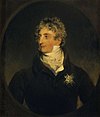Laurent de Gouvion Saint-Cyr
Laurent de Gouvion Saint-Cyr, 1st Marquis of Gouvion-Saint-Cyr (French pronunciation: [loʁɑ̃ də ɡuvjɔ̃ sɛ̃ siʁ]; 13 April 1764 – 17 March 1830) was a French military commander in the French Revolutionary and Napoleonic Wars who rose to the rank of Marshal of the Empire. He is regarded as Napoleon's finest commander in defensive warfare.
Early life
He was born Laurent Gouvion in Toul, Three Bishoprics (now Meurthe-et-Moselle), the eldest child of Jean-Baptiste Gouvion, a tanner, and his wife Anne-Marie Mercier. He adopted the name Saint-Cyr after his mother, who had abandoned him at an early age.
He went to Rome when he was eighteen in order to study painting, but, although he continued his artistic studies after his return to Paris in 1784, he never adopted the profession of a painter.
He married Anne Gouvion (Toul, 2 November 1775 – Paris, 18 June 1844) and had issue, including Laurent François, Marquis de Gouvion Saint-Cyr (30 December 1815 – 30 January 1904), married in Saint-Bouize on 17 August 1847 to Marie Adélaïde Bachasson de Montalivet (5 November 1828 – 14 April 1880), daughter of Marthe Camille Bachasson, Count of Montalivet, and had issue.
Revolutionary Wars

In 1792, Saint-Cyr was chosen as a
.In 1798 he succeeded
In 1801, Saint-Cyr was sent to Spain to command the army intended for the invasion of Portugal (see War of the Oranges), and was named grand officer of the Legion of Honour. When a treaty of peace was shortly afterwards concluded with Portugal, he succeeded Lucien Bonaparte as ambassador at Madrid.
Napoleonic Wars

Saint-Cyr was a stoic in an age of pragmatism and glory. His refusal to sign the proclamation of congratulation for declaring the birth of the empire resulted in his name not being included in the first list of Napoleonic Marshals, while commanders such as
He was still a
In October 1812, Saint-Cyr was
Last years
During the
In literature
Marshal Saint-Cyr is mentioned in Joseph Conrad's short story "The Duel" (as well as Ridley Scott's film adaptation The Duellists) as the commander of Armand d'Hubert after the second and final restoration of Louis XVIII as King of France. He is also mentioned in Stendhal's "The Red and the Black".
Writings
- Journal des opérations de l'armée de Catalogne en 1808 et 1809 (Paris, 1821)
- Mémoires sur les campagnes des armées de Rhin et de Rhin-et-Moselle de 1794 à 1797 (Paris, 1829)
- Mémoires pour servir de l'histoire militaire sous le Directoire, le Consulat et l'Empire (1831)
References
- This article incorporates text from a publication now in the public domain: Chisholm, Hugh, ed. (1911). "Gouvion Saint-Cyr, Laurent, Marquis de". Encyclopædia Britannica. Vol. 12 (11th ed.). Cambridge University Press. p. 292. In turn, it cites as reference Léonard Honoré Gay de Vernon's Vie de Gouvion Saint-Cyr (1857)
- Chandler, David (editor). Napoleon's Marshals. London: Macmillan Publishing Company, 1987. ISBN 0-297-79124-9




